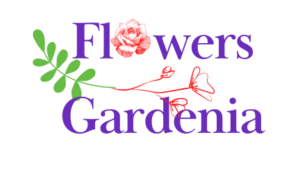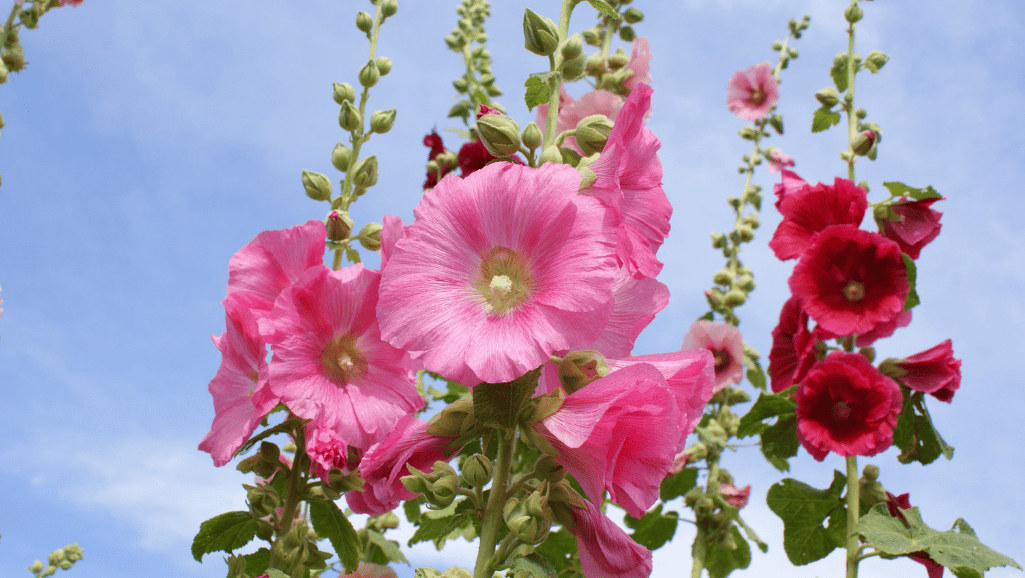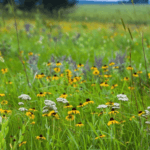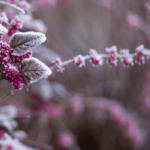
Beautiful flowers gardenia Plants For Your homes

The hollyhock (Alcea rosea) is a favorite in gardens for its tall stature and wide range of colors. It’s known for drawing in pollinators and making a bold statement. To get the most out of these flowers, learning how to care for them is essential.
With the right soil and sunlight, hollyhocks can grow tall and full of life. By following the right gardening tips, your garden can be filled with these beautiful flowers. They bloom from summer to fall, adding color and beauty to your outdoor space.
The hollyhock plant, known as Alcea rosea, is a favorite in cottage gardens. It’s loved for its tall, colorful ornamental flowers. To grow this plant well, you need to know the basics. Hollyhocks grow in zones 3 to 9, fitting many climates.
Alcea rosea plants can grow up to 6-8 feet tall and spread 1-2 feet wide. They love full sun and rich, well-drained soil. They are biennial, living two years, but often act like perennials, coming back every year.
| Variety | Height | Spread | Color |
|---|---|---|---|
| Alcea rosea ‘Blacknight’ | 5-6 feet | 1-2 feet | Deep Purple |
| Alcea rosea ‘Mars Magic’ | 5-6 feet | 2 feet | Red |
| Alcea rosea ‘Queeny Purple’ | 2-3 feet | 2-3 feet | Light Purple |
| Alcea rosea ‘Chater’s Double’ | 5-7 feet | 1-2 feet | Variety of Colors |
Hollyhocks are beautiful and attract birds, bees, and butterflies. Alcea rosea comes in many colors, from blue to red. ‘Blacknight’ has deep purple petals, adding mystery and elegance.
To grow hollyhocks, start with the right planting techniques. Seeds take 1-2 weeks to germinate. Plant them in late summer to give seedlings a head start before winter.
Feed hollyhocks every 6-8 weeks to help them grow tall and bloom heavily. They grow well in many soils, making them easy to add to any garden. Alcea rosea is perfect for cottage gardens or borders, offering beauty and resilience.
Gardeners often ask how to plant hollyhocks for a beautiful display. Timing and technique are key. This section will cover the best seasons and methods to help your hollyhocks grow well.
Planting hollyhock seeds at the right time is crucial. Early spring, after the last frost, is perfect for starting seeds outside. For cooler areas, start seeds indoors 8 to 10 weeks before the last spring frost. This way, plants get a head start before summer heat.
Choosing the right way to plant hollyhock seeds is important. Hollyhock seeds need sunlight to grow, so just press them into the soil lightly. If starting seeds indoors, use small pots to avoid root damage when transplanting. This helps their sensitive roots grow strong.
When moving hollyhocks, handle them gently to protect their roots. Make sure the soil is airy and moist when transplanting. The best time to move them outside is after all frost is gone and they have a few true leaves.
| Month | Activity | Growth Stage |
|---|---|---|
| April-May | Sow hollyhock seeds undercover | Germination |
| May-July | Transplant outdoors | Seedling establishment |
| July-September | First blooms (second year) | Flowering |
With the right hollyhock growing tips, these classic garden plants can bring beauty for years. They’re perfect for back borders or as highlights along walls or fences. Hollyhocks add a charming touch to any garden.
For garden plants like hollyhocks, knowing the best soil conditions for flowers is key. Hollyhocks do well in soil that’s rich, drains well, and holds moisture. This is vital for hollyhock maintenance and keeping the plant healthy and long-lasting.
To get the best results, add organic stuff like compost, aged manure, or leaf mold to the soil. This boosts the nutrients and helps the soil drain and hold moisture better. These are all important for taking care of hollyhocks.
| Soil Condition | Importance | Recommendation |
|---|---|---|
| Drainage | Prevents root rot | Ensure soil is loose and not compacted |
| Organic Matter | Nutrient content | Mix compost or manure into the top 6-8 inches |
| pH Level | Optimal nutrient uptake | Aim for a pH between 6 and 8 |
| Sun Exposure | Maximizes flowering | Position in full sun, minimum 8 hours daily |
As shown by So Right Seeds, choosing a spot with some shelter and lots of sun is best. It protects from wind and helps the plants bloom well. Also, the soil’s condition is crucial for growing these beautiful garden plants.
Even though hollyhocks can adapt, the right soil and spot make a big difference. This leads to a garden full of tall, colorful flowers.
Hollyhock care is key to getting the most out of these bright flowers. We’ll cover the best ways to water and feed them for their health and beauty.
Watering hollyhocks regularly is a must, especially when they’re growing fast. Keep the soil moist to 15cm deep but avoid making it too wet. Young plants need more water to grow strong roots. Always check the topsoil to make sure it’s moist, which is crucial for these plants.
Fertilizing is important for hollyhocks to grow well and bloom beautifully. Use a 10-10-10 fertilizer every few weeks in spring and summer. This helps the plant stay healthy and increases the number of flowers it produces. For plants in pots, a liquid fertilizer is best to meet their nutritional needs.
By taking good care of your hollyhocks with the right watering and feeding, you’ll get strong plants and lots of beautiful flowers. Following these tips will make your garden look stunning with these lovely plants.
Keeping hollyhock gardens bright and beautiful requires careful hollyhock maintenance and hollyhock care. Start by staking tall plants to keep them upright all season. It’s also key to prune them, cutting off dead flowers to make way for new growth and extend their bloom time.
To fight off diseases like hollyhock rust, clean up your garden at the end of the season. Remove all dead plant material to prevent fungi from surviving the winter. This step is crucial for gardening tips to keep your garden healthy.
When it comes to plant care tips, hollyhocks need the right watering and feeding. They usually get enough rain but may need extra water in dry spells. Make sure not to overwater, as this can harm the roots. Feed them a slow-release fertilizer every 4-6 weeks to help them grow strong.
By following these hollyhock maintenance steps, your garden will be a burst of color and life. These tips show how rewarding hollyhock care and gardening tips can be.
Hollyhocks add beauty and color to gardens. But, they need care to stay healthy. Knowing about common diseases and pests helps. It’s important to prevent and treat problems early.
Hollyhock rust is a big problem for gardeners. It’s caused by Puccinia malvacearum and spreads in warm, humid places. It turns leaves yellow or brown. Catching it early and treating it is key to save the plant.
Before adding new plants, check for rust. This stops the disease from spreading.
Many pests, like weevils and Japanese beetles, harm hollyhocks. Hollyhock weevils are a big problem in June and July. Japanese beetles eat a lot of the plant.
Good care can help prevent hollyhock diseases and pests. Use prevention and treatment together. This way, you can enjoy hollyhocks all season.
Learning how to spread hollyhock propagation can make your hollyhock garden last forever. These tall, colorful plants can be easily shared by collecting and planting their seeds. This way, you can keep enjoying their beauty year after year.
After the flowers fade from July to September, don’t forget the seed pods. When they turn brown and dry, they’re ready to open and release seeds. Store these seeds well until spring to plant them again.
Spring is the best time to plant hollyhock seeds. They need light and a bit of moisture to grow. In about 14 to 21 days, they will start to sprout. Make sure to give each seedling enough space, about 50 to 60 cm apart, as they grow big.
| Variety | Height | Flowering Period | Notes |
|---|---|---|---|
| Alcea rosea ‘Nigra’ | 2 – 2.5 meters | July-September | Dark flowers, dramatic effect |
| Alcea ficifolia | Up to 3 meters | July-September | Resistant to rust, hardy |
| Alcea rosea Spotlight ‘Mars Magic’ | 1.6 – 1.8 meters | July-September | Vibrant red blooms |
| Alcea pallida | 1.8 – 2.5 meters | May-October | Long blooming period |
Hollyhock gardens love the sun and need good soil. A soil mix that drains well helps their roots grow strong. Watering and feeding them a bit will make them bloom more, making growing hollyhocks a joy for gardeners.
Hollyhocks are known for their tall stature and bright colors. They are a key part of cottage gardens and add beauty to landscapes. These plants can be biennials or perennials, depending on the conditions. This knowledge helps gardeners plan for their growth and blooms.
Hollyhocks are usually biennials but can act like perennials in good conditions. They have a strong root system that helps them survive seasons. Perennial hollyhocks can spread by self-seeding, making it seem like they grow on their own. This means they can bloom every year without needing to be replanted often.
There are many colors and types of hollyhocks to choose from, like ‘Radiant Rose’ and ‘Powder Puffs’ mix. These options let gardeners match their plants with their garden’s theme. The tall hollyhock flowers add drama to gardens, standing above other plants.
By picking hollyhocks that bloom at different times, gardeners can have flowers all season. Each flower is about 3-5 inches wide and makes the garden look stunning. Hollyhocks are perfect for those who want to make a statement with tall flowers.
Using different types of hollyhocks can create beautiful displays that attract bees and butterflies. Hollyhocks add more than beauty to gardens; they help the local ecosystem by supporting pollinators.
The hollyhock flower stands tall as a summer bloomer, adding beauty to gardens and floral arrangements. Its vibrant spires bring drama and texture to any setting. This ornamental plant is perfect for adding height and beauty.
To keep your hollyhock arrangements looking great, pick stems with about one-third of the flowers open. This method helps the flowers last 7 to 10 days in a vase. For tips on keeping hollyhock flowers fresh, check out these expert steps here.
Pair hollyhock flowers with blooms like bellflowers, phlox, and baby’s breath for stunning arrangements. Adding classic roses can make the arrangement feel like a summer garden inside.
Hollyhocks are key in ornamental plant design. They stand out with their tall stature and colorful blooms. They can be the main attraction in big arrangements or elegant centerpieces.
Here’s a guide to making different floral arrangements with hollyhock flowers:
| Flower Type | Color Palette | Complementing Flowers |
|---|---|---|
| Hollyhock | Indigo, Magenta, Light Yellow | Bellflowers, Phlox |
| Roses | Peach, Dark Yellow | Baby’s Breath, Hollyhock |
For those who love hollyhocks, making paper hollyhocks is a fun project. You can customize colors and sizes for personal decor or events. You’ll need different paper shades and some folding and cutting skills.
Using fresh or paper hollyhocks, these arrangements can brighten any space. Let the beauty of the hollyhock inspire your next project. It could be for a special event, home decor, or just to brighten a corner.
Hollyhocks bring drama and beauty to a garden. They also help attract pollinators, making your garden a lively place. By adding hollyhocks, you create a space that’s full of life and looks like a classic cottage garden.
Hollyhocks stand tall with beautiful flowers. They’re more than just pretty cottage garden plants. They help attract pollinators like bees, butterflies, and hummingbirds. These insects are key for pollinating many garden plants.
Hollyhocks offer nectar for pollinators during their bloom. By choosing different hollyhock types, you can keep your garden feeding pollinators all season. This variety helps many pollinators, which is good for other cottage garden plants.
Using companion planting is smart in garden design. Pairing hollyhocks with plants like dahlias and roses makes your garden more diverse. It also draws in more pollinators. This mix helps plants grow better and supports more wildlife.
By using hollyhocks to attract pollinators, you help local wildlife and make your garden look great. Adding these cottage garden plants to your garden boosts its beauty and biodiversity. It’s a smart move for any garden, new or old.
A garden without hollyhocks is like a sky without stars. Hollyhocks bring a touch of cottage garden flower charm with their tall stature and beautiful blooms. They are not only stunning but also easy to grow. These perennial plants have been a delight in gardens for centuries.
Hollyhocks can live for a few years but are often treated as biennials. They are easy to reseed and have strong roots. However, they can face leaf rust, which can be prevented with proper care. Proper spacing and watering can help keep them healthy.
They grow up to 9 feet tall and can thrive in many soils. Their care includes soaking seeds and watering in winter. These factors make them successful in gardens and highlight the hollyhock benefits.
The hollyhocks bloom beautifully by the second year, showing the beauty of gardening. They add color to gardens, can be cut for indoor arrangements, and attract pollinators. With the right care, they can continue to enchant people and support biodiversity for years.




